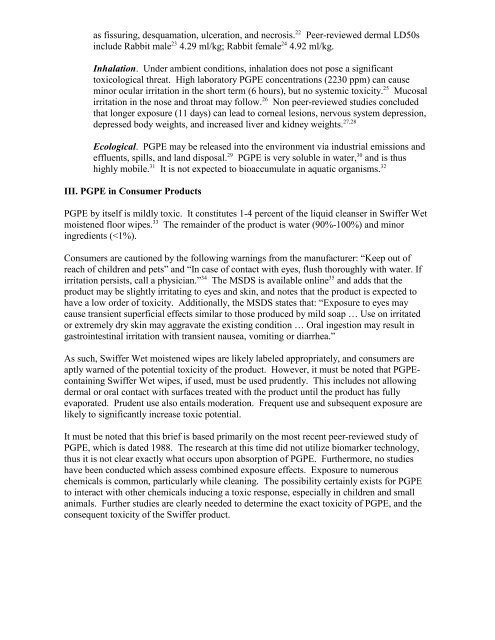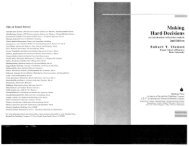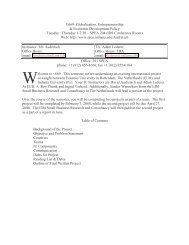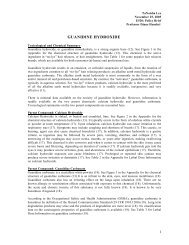22 as fissuring, desquamation, ulceration, and necrosis. Peer-reviewed dermal LD50s 23 24 include Rabbit male 4.29 ml/kg; Rabbit female 4.92 ml/kg. Inhalation. Under ambient conditions, inhalation does not pose a significant toxicological threat. High laboratory PGPE concentrations (2230 ppm) can cause 25 minor ocular irritation in the short term (6 hours), but no systemic toxicity. Mucosal 26 irritation in the nose and throat may follow. Non peer-reviewed studies concluded that longer exposure (11 days) can lead to corneal lesions, nervous system depression, depressed body weights, and increased liver and kidney weights. 27,28 Ecological. PGPE may be released into the environment via industrial emissions and 29 30 effluents, spills, and land disposal. PGPE is very soluble in water, and is thus 31 32 highly mobile. It is not expected to bioaccumulate in aquatic organisms. III. PGPE in Consumer Products PGPE by itself is mildly toxic. It constitutes 1-4 percent of the liquid cleanser in Swiffer Wet 33 moistened floor wipes. The remainder of the product is water (90%-100%) and minor ingredients (
1 1-<strong>PROPOXY</strong>-2-<strong>PROPANOL</strong> CAS: 001569-01-3 Erich Eschmann 11/24/04 For example: Armor All Multi Purpose Cleaner, Multipurpose Auto Cleaner, Rim Cleaner; Swiffer WetJet Wood Cleaner, Swiffer Wet, Swiffer WetJet Advanced Cleaner; Evercare Glass Wipes, Pre Moistened; Minwax Clear Shield Weather Resistant Coating for Wood, Satin-4185, Minwax Clear Shield Weather Resistant Coating for Wood- Semi Gloss 4180 (see: http://householdproducts.nlm.nih.gov/cgibin/household/brands?tbl=chem&id=2081, 11/20/04) 2 See http://www.truthorfiction.com/rumors/s/swiffer.htm, http://www.breakthechain.org/exclusives/swifferdog.html, http://www.trendmicro.com/vinfo/hoaxes/hoax5.asp?HName=Swiffer+WetJet++Warning+Hoax, http://www.snopes.com/critters/crusader/swiffer.asp, http://urbanlegends.about.com/library/bl_swiffer_wetjet.htm, (11/20/04) 3 http://www.homemadesimple.com/swiffer/usenglish/products/wetjet.shtml (11/20/04) 4 http://www.aspca.org/site/News2?news_iv_ctrl=1400&page=NewsArticle&id=16054&security=2220 (11/20/04) 5 Hall, SK, Chakraborty, J, and RJ Ruch. Chemical Exposure and Toxic Responses CRC Lewis Publishers: 1997. p.49 6 Ballantyne B, Myers RC, & Losco PE: The acute toxicity and primary irritancy of 1-propoxy-2-propanol. Veterinary and Human Toxicology; 30:126-129. 1988. 7 Ballantyne B, Myers RC, & Losco PE: The acute toxicity and primary irritancy of 1-propoxy-2-propanol. Veterinary and Human Toxicology; 30:126-129. 1988. 8 th Klaasen, CD: Casarett and Doull’s Toxicology, 6 Ed. McGraw Hill, NY, 2001. p.898 9 th Klaasen, CD: Casarett and Doull’s Toxicology, 6 Ed. McGraw Hill, NY, 2001. p.897 10 th Klaasen, CD: Casarett and Doull’s Toxicology, 6 Ed. McGraw Hill, NY, 2001. p.897 11 Ballantyne B, Myers RC, & Losco PE: The acute toxicity and primary irritancy of 1-propoxy-2-propanol. Veterinary and Human Toxicology; 30:126-129. 1988. 12 Ballantyne B, Myers RC, & Losco PE: The acute toxicity and primary irritancy of 1-propoxy-2-propanol. Veterinary and Human Toxicology; 30:126-129. 1988. 13 Ballantyne B, Myers RC, & Losco PE: The acute toxicity and primary irritancy of 1-propoxy-2-propanol. Veterinary and Human Toxicology; 30:126-129. 1988. 14 Ballantyne B, Myers RC, & Losco PE: The acute toxicity and primary irritancy of 1-propoxy-2-propanol. Veterinary and Human Toxicology; 30:126-129. 1988. 15 Ballantyne B, Myers RC, & Losco PE: The acute toxicity and primary irritancy of 1-propoxy-2-propanol. Veterinary and Human Toxicology; 30:126-129. 1988. 16 Ballantyne B, Myers RC, & Losco PE: The acute toxicity and primary irritancy of 1-propoxy-2-propanol. Veterinary and Human Toxicology; 30:126-129. 1988. 17 Ballantyne B, Myers RC, & Losco PE: The acute toxicity and primary irritancy of 1-propoxy-2-propanol. Veterinary and Human Toxicology; 30:126-129. 1988. 18 Patty, FA: Patty's industrial hygiene and toxicology CD-ROM. 1996. 19 Smyth, H.F. Range finding toxicity data List VII. American Industrial Hygiene Association Journal 30: 470- 476. 1969. 20 Ballantyne B, Myers RC, & Losco PE: The acute toxicity and primary irritancy of 1-propoxy-2-propanol. Veterinary and Human Toxicology; 30:126-129. 1988. 21 Ballantyne B, Myers RC, & Losco PE: The acute toxicity and primary irritancy of 1-propoxy-2-propanol. Veterinary and Human Toxicology; 30:126-129. 1988. 22 Ballantyne B, Myers RC, & Losco PE: The acute toxicity and primary irritancy of 1-propoxy-2-propanol. Veterinary and Human Toxicology; 30:126-129. 1988. 23 Ballantyne B, Myers RC, & Losco PE: The acute toxicity and primary irritancy of 1-propoxy-2-propanol. Veterinary and Human Toxicology; 30:126-129. 1988. 24 Ballantyne B, Myers RC, & Losco PE: The acute toxicity and primary irritancy of 1-propoxy-2-propanol. Veterinary and Human Toxicology; 30:126-129. 1988. 25 Ballantyne B, Myers RC, & Losco PE: The acute toxicity and primary irritancy of 1-propoxy-2-propanol. Veterinary and Human Toxicology; 30:126-129. 1988. 26 Ballantyne B, Myers RC, & Losco PE: The acute toxicity and primary irritancy of 1-propoxy-2-propanol. Veterinary and Human Toxicology; 30:126-129. 1988. 27 Union Carbide Corporation, Bushy Run Research Center, Project Report 27-153, dated November 25, 1964 28 Union Carbide Corporation, Bushy Run Research Center, Project Report 49-120, dated January 15, 1987.








